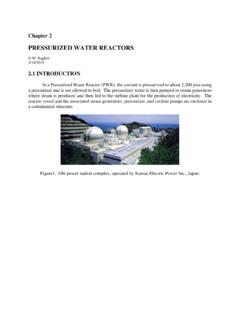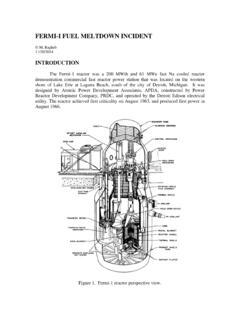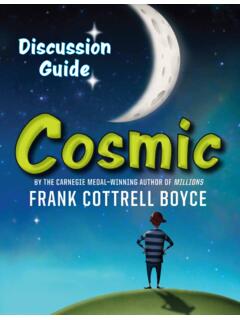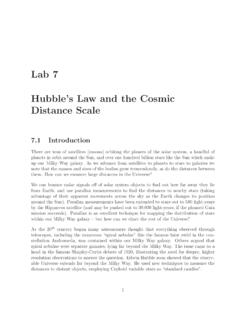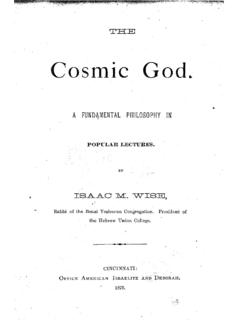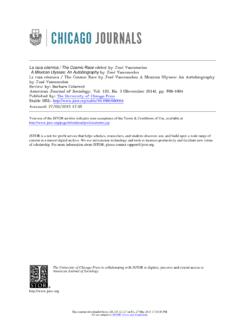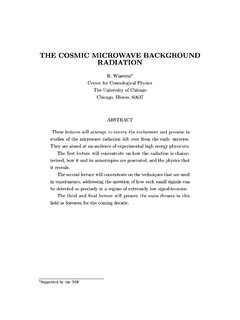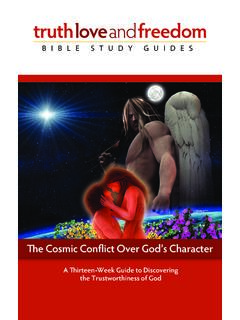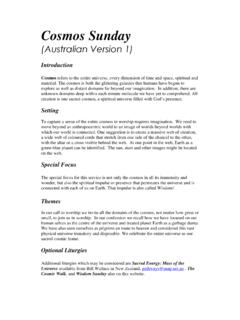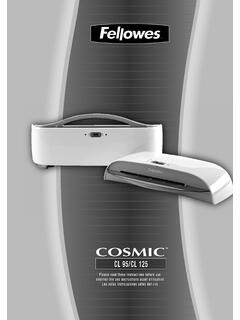Transcription of COSMIC AND SPACE RADIATION - mragheb.com
1 Chapter 4 COSMIC AND SPACE RADIATION M. Ragheb 7/19/2018 INTRODUCTION Even though we do not feel or see them, our bodies on Earth are bombarded every moment of the day and night by COSMIC rays and their interaction products coming to us from the depth of SPACE . These particles contribute to the natural RADIATION environment that living creatures on Earth are subjected to. It is also important to study the effects of SPACE RADIATION in SPACE missions from the perspective of its effects on living organisms such as astronauts in orbiting SPACE stations, or in bases on the moon or Mars, as well as the materials used in the SPACE environment particularly the shielding materials and the electronic and life support equipment. Figure 1.
2 Astronaut Harrison H. Schmitt in the Apollo 17 mission on the moon, December 19, 1972. Figure 2. Mars, possible site of a future manned SPACE mission. Source: NASA. Two forms of RADIATION are encountered on SPACE missions: 1. Galactic COSMIC Rays (GCRs) are particles caused by supernova explosions and other high-energy events outside the solar system. 2. Solar Energetic Particles (SEPs) which are are associated with the solar flares and coronal mass ejections from the sun. Current spacecraft shield much more effectively against the SEPs than the GCRs. To protect against the low energy of typical SEPs, astronauts will need to move into shielded enclosures with extra shielding on a spacecraft or on the Martian surface. GCRs tend to be highly energetic, highly penetrating particles that can propagate unaffected through the structure or decay into secondary particles that are not stopped by the modest shielding provided by existing typical spacecraft [7].
3 SPACE is characterized by the presence of high energy particles. A typical high energy particle of RADIATION found in the SPACE environment is ionized all by itself. As it passes through material such as human tissue it also disrupts the electronic clouds of the constituent molecules and leaves a path of ionization in its wake. These particles are either singly charged protons or more highly charged nuclei called "HZE" particles. Here Z is the symbol for nuclear charge and the disruption caused is proportional to Z2. Thus a particle with High Z and high Energy is called an HZE particle. Particles encountered in SPACE commonly have enough energy to disrupt the nucleus of target atoms and these collisions can cause nuclear reactions which generate new and potentially more damaging particles.
4 The possible occurrence of nuclear reactions makes the analysis of ionizing RADIATION collisions difficult. COSMIC RADIATION Since their discovery, there has been a lot of hypotheses about the origin and the process of generation of COSMIC rays. They span the two areas of astronomy on a large scale, and particle physics, on a small scale. Most of the important knowledge in subatomic particle physics originated in the field of COSMIC rays studies. In 1932, the first antimatter particle, the positron, was identified in the products of COSMIC ray impacts. The muon and the pion were discovered a few years later. The cloud chamber detection device was invented in 1896 by Charles T. R. Wilson (Fig. 3). Figure 3. Charles T.
5 R. Wilson invented the cloud chamber in 1896. It depends on the use of a saturated vapor or liquid under its saturation pressure. Charged particles generate tracks in them similar to the condensation trails or contrails caused by airplanes in the atmosphere. Figure 4 shows a cloud chamber photograph of a nuclear disintegration resulting from a COSMIC ray collision. Figure 4. Cloud chamber photograph of a nuclear disintegration resulting from a COSMIC ray collision. COSMIC rays are exotic types of subatomic particles that are beyond the production capabilities of our most powerful particle accelerators. Their study elucidates crucial details about the objects and the processes that generated them, which is also beyond the capabilities of optical telescopes.
6 Black holes neutron stars, supernovae and quasars may all have roles in their generation. Primary COSMIC ray nuclei have spent a long time in the millions of years scale reaching the Earth. During their travel, they traverse about an areal density or the product of density-thickness product of: []gmxcm of matter. This is equivalent to a thickness of 3 cms of water with a density of 1 gm/cm3, or a thickness of iron of cms at a density of gm/cm3. They arrive at the Earth in an isotropic distribution. They appear to have existed in the same numbers for longer than a billion years. Nowadays, COSMIC RADIATION is thought to originate from other parts of our Milky Way Galaxy. Some of the COSMIC rays come to us from the sun. These have low energies at best up to hundreds of GeVs.
7 This RADIATION reaches all parts of the Earth s surface. They are more intense at higher altitudes, but are very penetrating and persist in deep caves and mines. Figure 5. Black hole thought to exist at the center of the Milky Way Galaxy. Active galaxies and the black holes (Fig. 5) that power them are thought to be the prime sites for the accelerating the highest energy COSMIC rays. It is surmised that a black hole exists at the center of the Milky Way galaxy. These highly accelerated particles interact with some nuclei in the atmosphere to produce COSMIC ray showers. Astronauts and aircraft crews and passengers are exposed to significantly higher amounts of RADIATION than people on the ground. The latter have the protection of the atmosphere to attenuate the particles resulting from the showers.
8 At least one airline, Lufthansa, bars its female flight attendants from flying when they are pregnant to avoid the RADIATION effects on the growing fetuses. COSMIC RAY PARTICLES The major components of a COSMIC ray extensive air shower includes pions ( +, -, 0) and kaons ( +, -), that are produced in the initial interaction with an atmospheric nucleus. Protons and neutrons are also produced. Charged pions may decay to produce muons ( ) and neutrinos ( ). The electromagnetic cascade of negatrons (negative electrons) (e-), positrons (e+), gamma rays ( ) is initiated by the decay of a neutral pion ( 0). Figure 6. Components of a COSMIC ray shower in the atmosphere. Some large showers would reach the lower atmosphere with an intensity I = 1 million (106) particles with an energy of E = 10 MeV on the average each.
9 These particles would have been attenuated in the atmosphere by a factor f = 100. Thus the initial energy E0 in the particle initiating the shower would be: 10 particles 10 () 100 10 () particleMeV = 10 eV = 10 [GeV].EI E f (1) Table 1. Table of the Subatomic Particles. Family Symbol Name Electric Charge Mass (MeV) Half Life (seconds) Common Decay Products Antiparticle HADRONS Baryons (Strongly Interacting Fermions) Spin= half integral p proton nucleon +e stable *p antiproton n neutron nucleon 0 stable (in nucleus) 7x 102 (free state) p, e, e *n antineutron lambda hyperon 1, p, - p, 0 antilambda + sigma plus hyperon +e 1, 10-10 p, 0 n, + - anti sigma minus 0 sigma zero hyperon 0 1, < 10-14 + RADIATION 0 anti sigma zero - sigma minus hyperon -e 1, n, - + anti sigma plus - xi minus cascade hyperon -e 1, - + anti xi plus 0 xi zero cascade hyperon 0 1, 0 - anti xi zero Mesons (Strongly Interacting Bosons)
10 Spin = 0 + pion +e - pi minus - pi minus -e + pi plus 0 pi zero 0 RADIATION 0 pi zero + kaon +e +, - - K minus - k minus -e -, 0 + K plus 0 k zero 0 (fast mode) 4x10-8 (slow mode) + -, 2 0 3 0, + - 0 + + e e - - e e 0 anti K zero 0 anti K zero 0 (fast mode) 4x10-8 (slow mode) + -, 2 0 3 0, + - 0 + + e e - - e e 0 K zero omega 0 x 10-23 J or J particle 0 3, 10-10 J or eta 0 < 10-16 3 0. 0 + - + + + RADIATION RADIATION eta ELEMENTARY PARTICLES Massless Bosons, Classons Spin = 1 h photon 0 0 stable ( ) Spin = 2 h g graviton 0 0 stable (g) Leptons (Weakly Interacting Fermions) Spin=1/2 h or muon -e x 10-6 e or or tau particles -e x 10-13 tau neutrino about 0 stable (?)



